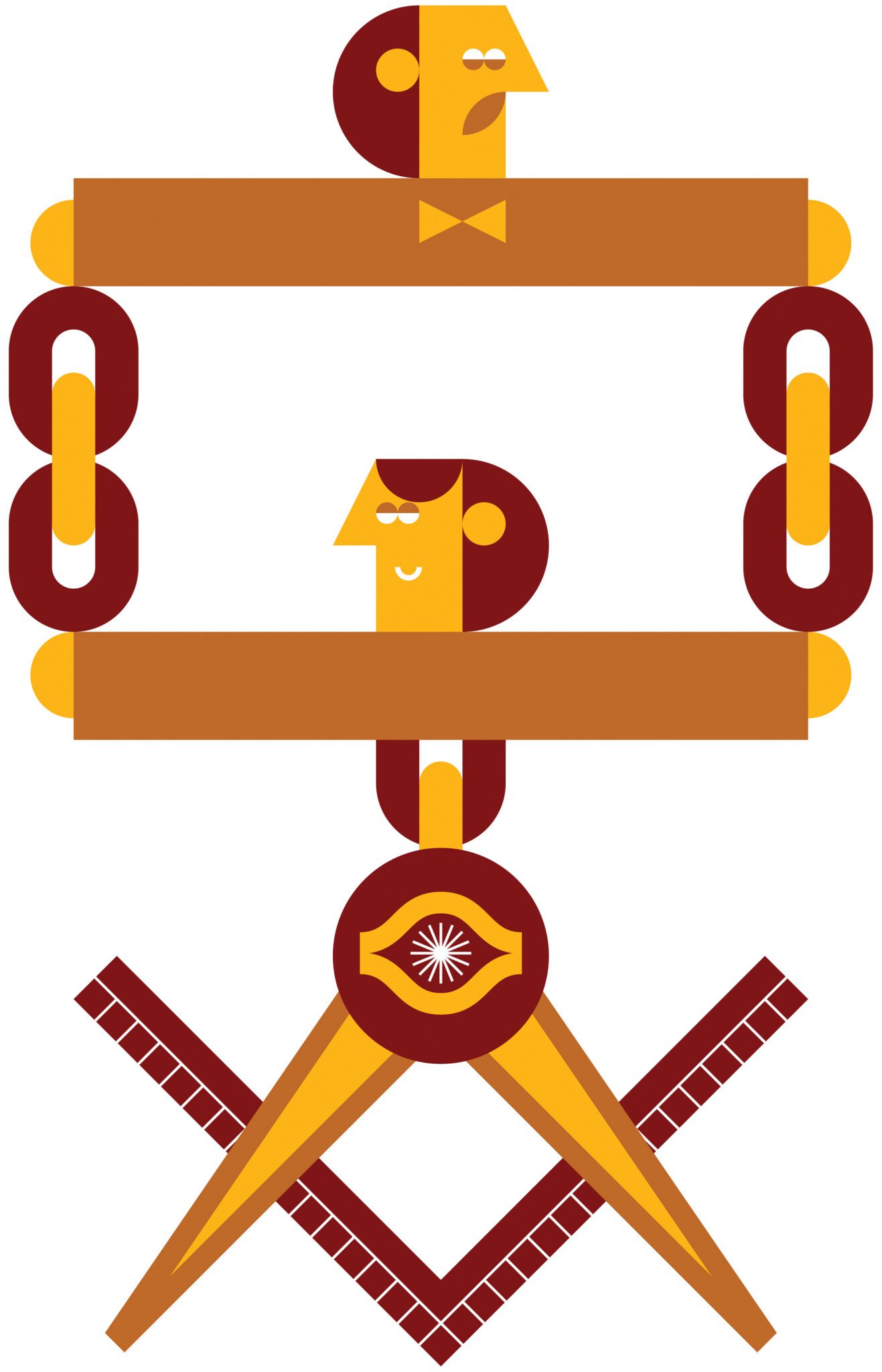
The Lewis Degree: A Masonic Ceremony Generations in the Making
For the select group of Masonic father-and-son combos, the Lewis Degree is a special ceremony binding generations of Masons.
It’s a warm summer evening in San Francisco as patrons line up to enter the California Masonic Memorial Temple. In less than an hour, the comedian Chris Rock will begin his set. As is increasingly common, guests have been asked to lock away their phones, so the queue to pass through the front doors is backed up onto California Street, where the city’s iconic cable cars periodically roll by.
Despite the slow-moving line, tonight’s audience seems to be in good spirits, displaying the cheerful giddiness of a big night out. That’s a near permanent fixture here, as the auditorium stage is host to some 79 live shows per year, along with numerous private and corporate events. In all, about 250,000 visitors pass through the doors of the California Masonic Memorial Temple annually, making it one of the city’s most visited venues.
Drinks in hand, the guests make their way to their seats. On their way, they pass by several noteworthy markers: a golden square and compass carved into the white marble of the building’s façade; twin 23-foot-high marble columns flanking the front doors and topped by celestial and terrestrial globes; and the 48-by-38 foot endomosaic mural, full of images and references to the history of Freemasonry in California. A few snap photos of the evocative surroundings, but tonight’s crowd for the most part seems unaware of the architectural, historical, and especially fraternal significance of the building they’re visiting. In fact, a large majority are unlikely to even know the building’s full name. Outside of the fraternity, very few people ever refer to the California Masonic Memorial Temple. To most, it’s simply “the Masonic.”
That’s no accident. Since opening in 1958, the CMMT has always played a dual role. To the fraternity, it’s the general headquarters of the Masons of California—their meeting place, library, and the staff offices of the Grand Lodge of California. Its operations also support the charitable activities of the California Masonic Foundation. Externally, it’s an entertainment venue geared toward the enjoyment of a public with slim knowledge of Freemasonry. Now, almost 65 years later, there’s hope that the building—by whatever name it’s known—can play yet another role: as a vehicle to help propel Freemasonry in California into the future.
Freemasonry in California goes all the way back to the gold rush of 1848–50, when fortune seekers from around the world— including many Masons—flooded into the state. The Grand Lodge of California was initially established in April 1850 in the so-called Red House on Fifth and J streets in Sacramento, exercising jurisdiction over 11 lodges across California and Hawaii. Masons played an important role in securing California’s admission to the union in September 1850, and many of California’s early civic and business leaders were Masons, including Samuel Brannan, Thomas Starr King, and Leland Stanford.
The Grand Lodge relocated to San Francisco in 1863. For many years, it was headquartered in an impressive hall at the northwest corner of Post and Montgomery streets, where it remained until the 1906 earthquake, which destroyed the building. After meeting at various locations for several years, the Grand Lodge moved into the new San Francisco Masonic Temple at 25 Van Ness in 1913, where it stayed for nearly half a century. Designed by Bliss & Faville in the Venetian Revival style, the building is now operated by the city of San Francisco.

Postwar, the fraternity began to outgrow the Van Ness building and required, in the words of a later temple committee member, “more commodious quarters.” Membership in fraternal societies such as the Masons, the Elks, and the Odd Fellows surged after World War II. Between 1946 and 1953, the number of Masons in California nearly doubled, reaching a high of 225,000. That growth had a profound effect not just on the fraternity, but on the state as a whole. For members of the Greatest Generation, the war had been a tremendous social mixer, and the subsequent rise of suburbanization broke apart traditional ethnic enclaves. In the newly built suburbs, fraternal societies provided an Americanized alternative to traditional religious and ethnic-based organizations. In addition to opportunities for socializing, fraternal organizations offered a sense of belonging, especially with their ritualized pageantry and charitable activities.
By the late 1940s, the 20,000-square-foot Grand Lodge temple on Van Ness was straining to accommodate the yearly Annual Communication. By 1952, the situation was critical enough that the meeting was moved to the 8,500-capacity San Francisco Civic Auditorium, where it would be held for each of the next five years. Meanwhile, the administrative functions of the Grand Lodge were also severely short on space. A 1947 report commissioned by the Grand Lodge recommended finding a new home at once, to be ready for move-in by the fall of 1950.
The booming fraternity, which had added 100,000 members in less than a decade, needed a new home to match its new scale and ambition. So it looked to the top of the hill.
The location of today’s California Masonic Memorial Temple is significant, though it was perhaps a stroke of luck that it ever worked out. Standing proudly atop Nob Hill, one of San Francisco’s most coveted neighborhoods, the modernistic temple is a stark departure from the stately Beaux Arts hotels and apartment buildings that surround it. From the beginning, its location and design were meant to demonstrate a sense of the fraternity’s civic pride and institutional might. (Among its eminent neighbors are Grace Cathedral, the seat of the Diocese of California; the elite Pacific-Union Club; and the luxurious Fairmont Hotel, where Tony Bennett first sang “I Left My Heart in San Francisco.”)
The fraternity of the mid-20th century fit securely in among those lofty neighbors. But the location was also a manifestation of a forward-thinking vision for the fraternity and its headquarters—one that saw the organization playing an important role in the city’s social and commercial life. Unlike its previous locales, the new Grand Lodge temple would exist not solely to serve the members of the fraternity. Instead, revenue-generating elements of the building would help fund the Masons’ charitable arm (what would later become the California Masonic Foundation). And, with its planned exhibition hall and performance venue, it would become a fixture of the city’s business and entertainment scene—a draw for visitors and Masons alike. In that way, it would be a boon to the economic interests of Nob Hill and downtown San Francisco beyond.
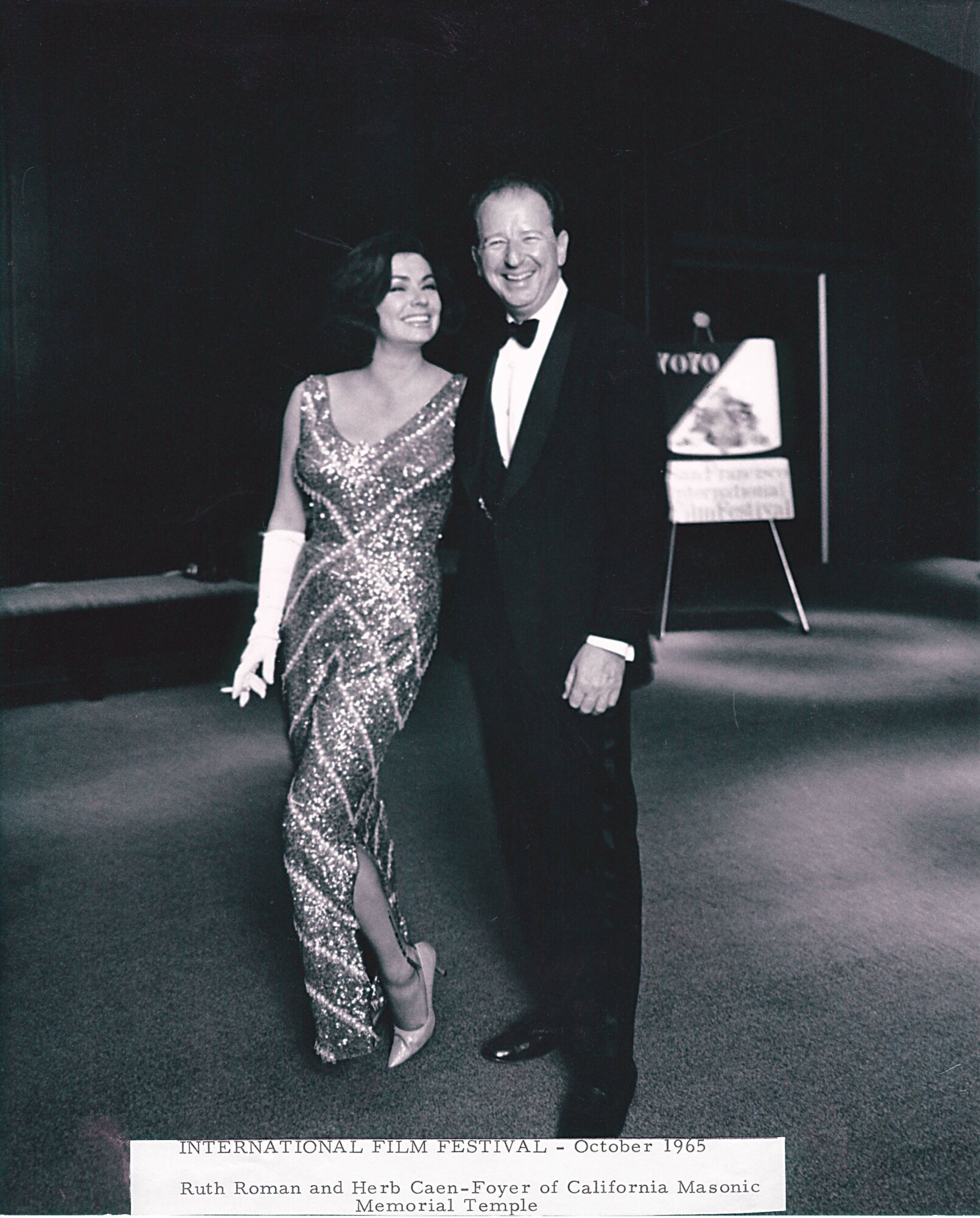
Given that backdrop, it’s interesting to note that the location on the corner of California and Taylor streets wasn’t the first choice for the new temple. Following the 1947 report, a committee devoted to the search for a new home identified 15 different sites in San Francisco to develop or refurbish. Ultimately, none of them were deemed suitable.
In early 1952, the committee identified a promising 12-story property at 201 Sansome, at the corner of Pine, owned by the San Francisco Stock Exchange and known as the Sub-Treasury Building. However, negotiations over the $3,000,000 sale fell through; meanwhile, a January 1952 arson at the Van Ness temple caused more than $100,000 in damages. Suddenly, the committee was under pressure to find a new home, fast. (“Make haste slowly” had been its winking motto.) After looking at several additional properties, in 1953 the committee turned its attention to the southwest corner of California and Taylor. The location, which at the time included a gas station and a four-story apartment building, stood opposite the in-progress Grace Cathedral and the Huntington Hotel. The 50,000-square-foot property had frontage on three streets—California, Taylor, and Pine—and was served by the California Street cable car line.
There were several obstacles to developing the Nob Hill site. First, it was zoned for residential use; second, it was expensive. To pay for the land, as well as the costs of constructing and operating the building, the Grand Lodge would have to build a temple with income-generating capability. However, zoning on Nob Hill wouldn’t allow for retail storefronts, which had helped subsidize the Van Ness temple.
Street parking was already at a premium in the neighborhood, especially with numerous hotels and apartment buildings nearby. Therefore, a five-level parking garage capable of accommodating over 500 vehicles became part of the building program. At the same time, the hotels provided opportunities for synergy. Many business conventions and trade shows had outgrown hotel ballrooms after the war, and the decision to include a large exhibition hall in the building’s design was probably made in consultation with the Fairmont Hotel owner Benjamin Swig, of Lincoln № 470 in San Francisco (since consolidated into Pacific-Starr King № 136). Swig, a major booster of the convention industry in the city, certainly would have approved of having an exhibition hall only a block from his flagship hotel. Another member of the temple committee certainly did: Walter Swanson, of Educator № 554 (now San Francisco № 120), was manager of the San Francisco Convention and Tourist Bureau.
Financing the project proved to be a tall order. The price of land for the site came to $1.3 million; plans for construction, including excavating the 62-foot drop from California Street south along Taylor, would come to more than $6 million. Two ideas for raising capital came to the fore: First, a 50-cent per capita fee that had been introduced in 1951 was raised to $1 per year in 1952; another $9 fee for new applicants was also directed toward building costs. Separately, a fundraising drive, initiated by Ernest Bashor, the chairman of the Masonic Homes Endowment Board, called on all members to contribute the equivalent of “one day’s wages”—what came out to approximately $9 per member—to the project. The names of each contributing member and lodge would be recorded in a public “open book,” to be put on display inside the memorial lounge. (Today that book is kept under glass on the mezzanine level.)
Meanwhile, architect Albert Roller got to work. Roller, who was a member of Excelsior № 166 (now San Francisco № 120), ably adapted the Masons’ vision to the site, placing the five-level parking garage within the building podium, or reinforced base level, which also contained the exhibition hall on the ground floor. The first floor, accessible by California Street, would serve as the building’s primary public access point, containing the 50-by-112-foot foyer and the 3,200-seat auditorium. Most of the second floor would be taken up by the auditorium’s mezzanine and the upper part of the foyer. The remainder was set aside for a library and an apartment for the grand master. Meanwhile, the third floor would house an office suite for the staff of the Grand Lodge, Masonic Homes, and other Masonic organizations. In February 1954, Albert Roller finished his preliminary designs. However, construction did not begin for another 20 months, as construction and fundraising delays pushed back the groundbreaking. The standing apartment house and gas station were finally demolished in January 1956, and excavation and construction followed a few weeks later. The contractor was MacDonald, Young & Nelson.
The temple committee stipulated that the temple’s design philosophy should evince “no stylized tradition or cliché,” in order to stand as a timeless monument. Roller designed the new building’s exterior in a sleek, modernist vocabulary that embodied influences of the “stripped classical” style of the 1930s. The exterior departs from the sometimes arid modernism of the 1950s. The only applied ornament was a memorial frieze by the late artist Emile Norman that, in keeping with the rest of the temple design, is reminiscent of New Deal–era aesthetics. At the left side are four panels depicting men from each of the branches of the armed forces, shown in ageless dress. At the right is a panel depicting a tug of war between the forces of good and evil, democracy and totalitarianism, with an inscription that reads: “Dedicated to Our Masonic Brethren Who Died in the Cause of Freedom.”
Beneath the frieze is a planter bed containing soil taken from each of California’s 58 counties and each of the Hawaiian Islands. (Hawaii fell under the Masonic jurisdiction of the Grand Lodge of California until 1989.) The bed contains a row of ornamental olive trees.
At the opposite end of the primary façade is the entrance porch. The porch roof is supported by a colonnade of squared-off columns made from Vermont marble, the same material used in the Lincoln Memorial in Washington, D.C. At the rear of the porch, flanking the entrance, are a pair of 23-foot-high marble pillars symbolizing the entrance to King Solomon’s Temple. Similar pillars flank the entrance to every Masonic lodge room. In Masonic custom, the pillar on the right is topped by a celestial orb, and the one on the left, the terrestrial.
The first-floor foyer is accessed from the entrance porch. The first thing you see upon entering the building is the stunning endomosaic window. Designed and executed by Norman, the window is made of thousands of pieces of colored glass sandwiched between layers of acrylic. The window comprises three sections, each divided into 15 panels, depicting the history of Masonry in California.
(For more about Emile Norman’s endomosaic, see this interactive explainer at freemason.org.)
Above:
The San Francisco Symphony performs the first concert inside the auditorium on April 19, 1958.
Finally, on October 27, 1955, more than 2,500 Masons attended the groundbreaking ceremony for the temple, as Grand Master Henry C. Clausen turned over a ceremonial spadeful of earth after ritually pouring corn, oil, and wine onto the ground. San Francisco mayor Elmer Robinson, a fellow Mason, declared the occasion “another great day in the history of San Francisco and the history of Masonry in California.”
Construction on the new temple was slow and frequently delayed. Strikes by the carpenters union and in the steel industry caused further slowdowns, and construction was halted on May 9, 1956, when a cave-in buried two workers, killing one. (The other, Kenneth Archer, was rescued after three hours.)
Fundraising for the project also proved difficult. The Grand Lodge had vowed not to borrow from the Masonic Homes endowment fund, meaning that members would be responsible for repaying all building costs. In 1954, Grand Master Frank Harwell wrote in the Proceedings of the Grand Lodge of the new temple’s long-delayed opening, “There is only one major unsettled question: When? The answer to that is very simple. When the Masons of California and the Hawaiian Islands provide the money. The process can be long or short. It is easily within your power to make it short.”
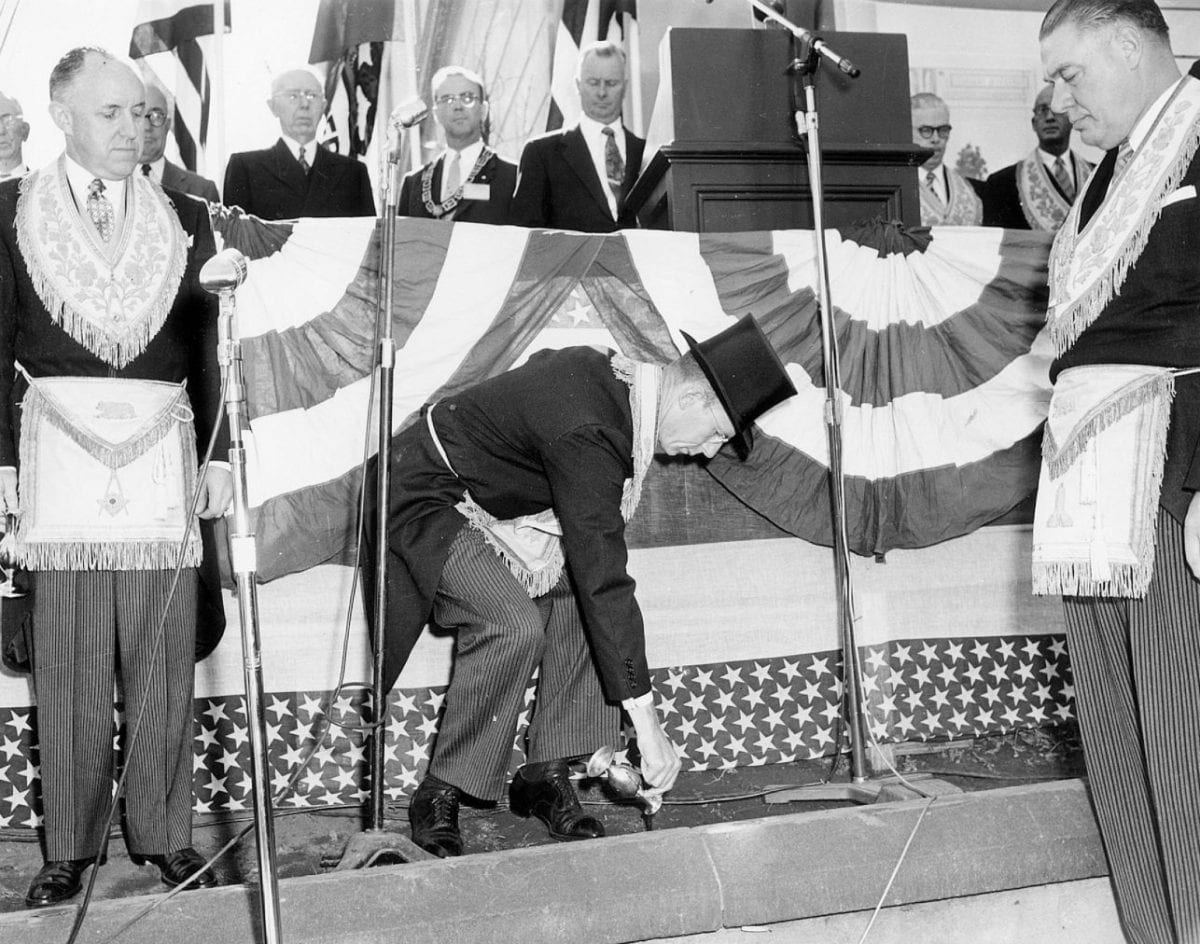
Under the “one day’s wages” theme, 123,890 members joined the “merit roll” of donors by the building’s opening. Some 457 lodges also received “merit roll” status. In 1954, those contributions totaled more than $700,000; in 1957, fundraising topped out at $1.7 million (about $18 million today).
Despite the delays, construction did inch along. The cornerstone of the temple was dedicated in October 1956 and the building frame topped out in April 1957. Six months later, the marble cladding on the exterior was in place. Writing in the 1957 Proceedings, Grand Master L. Harold Anderson marveled at the sight of the building rounding into shape.
“Hardly a day has passed since construction was started that I have not gone to the top of Nob Hill to watch the workmen at their labors,” he wrote. “I saw it as a mighty steel frame, showing the strength and mighty sinews of California Freemasonry. Then they poured the cement that united the structure into a common mass. And finally, as you will now see it, they adorned the Temple with beauty by applying the white Vermont marble slabs that face the building.… Brethren, a part of that building is mine. And even in its unfinished state it is among my most treasured possessions, because it is not something I have bought, but something I have given. I hope every California Master Mason will be able to look upon the California Masonic Memorial Temple with the same pride and sense of ownership.”
By April 1958, the interior was at last complete. However, the temple was not formally opened until the fall Annual Communication. The official dedication took place on September 29, 1958. Grand Master Leo Anderson presided over the ceremony, which was attended by Masonic dignitaries from 33 states and 11 countries. “This is our new home,” Anderson proclaimed, “a thing of beauty, a living testimonial to the strength and vitality of our great fraternity.” Fittingly, the first Masonic event held in the new temple wasn’t a ritual performance or even lodge business, but rather a meeting to discuss charity: On August 21, 1958, more than 1,200 Bay Area lodge officers gathered in the auditorium to discuss plans for Public Schools Week events that year.
Above:
Patrons gather beneath the massive Emile Norman endomosaic window in the foyer of the California Masonic Memorial Temple in San Francisco during the 172nd Annual Communication of Masons in 2021.
For nearly 65 years, the California Masonic Memorial Temple has dutifully served the needs of California’s Masons. Its income-producing components, including the parking garage, the exhibition hall, and the auditorium, have helped sustain the Grand Lodge, and revenues generated through them have supported the California Masonic Foundation. They’ve also made the temple a central component of San Francisco’s cultural life. The Masonic auditorium has hosted thousands of concerts by the likes of Barbra Streisand, Bob Dylan, Ella Fitzgerald, Ray Charles, Frank Sinatra, and many others. In 2010, the national concert promoter Live Nation took over management of the facility, and in 2014 it upgraded the auditorium, enlarging it to a capacity of 3,300.
The exterior of the building remains nearly unchanged, although in 1996 the Grand Lodge renovated meeting spaces on the exhibition level and relocated the library and museum there, at the corner of Taylor and California streets. In 2008, the library was moved back to the mezzanine level, and the vacated space was renamed the California Room.
The most significant change to the building’s interior came in 2019, when a different portion of the exhibition hall space was remodeled to include an intimate Masonic lodge room called Freemasons’ Hall, as well as an adjoining library, lounge, dining area, and bar. Today, eight different Masonic groups rent the space for their monthly meetings, including some that are not affiliated with the Grand Lodge of California. Now, for the first time since 1958, Masons have a place to practice the ritual, raise fellow Masons, and meet as brothers within the home of California Freemasonry.
The opening of Freemasons’ Hall may represent the building’s most consequential physical transformation to date, but it isn’t the only way in which the temple has evolved. This year, as part of the fraternity’s latest five-year operating plan, there’s a new emphasis on utilizing the temple to tell the story of California Freemasonry to the public. That means activating communal spaces, including the entrance porch, the endomosaic window, and the California Street exterior, with signage and digital access that allows curious passers-by and onlookers to learn more about the building’s history, its uses, and its meaning. Other programming is being developed that will allow the fraternity to tap into its most visible—and important—asset to help usher a new generation into the centuries-old tradition.
The California Masonic Memorial Temple stands as a testimony to the foresight of its builders. Over time, the public-facing elements of the temple have allowed it to thrive even as membership in the fraternity nationwide has declined by 75 percent. Now there’s evidence that the decades-long drop in membership is bottoming out, and that interest among millennials might reverse the trend. If so, the California Masonic Memorial Temple remains firmly rooted in place, ready to serve the needs of the fraternity—and the community—for years to come.
Writing about his hopes for the yet-to-be-built temple in 1953, Ernest Bashor, whose “one day’s labor” call helped fund construction and instilled a sense of shared ownership in the structure, summed up his feelings neatly. “We are now confronted with the desire and deep determination that a real monument may be established … one that will be useful for present-day activities, and one that will stand the ravages of time and forever be for our children and our children’s children a commanding landmark, and an inspiration to all Masons and the public at large.”
Above:
One of the many auto shows hosted inside the exhibition hall.
PHOTOGRAPHY BY:
Henry W. Coil Library and Museum of Freemasonry
Winni Wintermeyer (top)

For the select group of Masonic father-and-son combos, the Lewis Degree is a special ceremony binding generations of Masons.
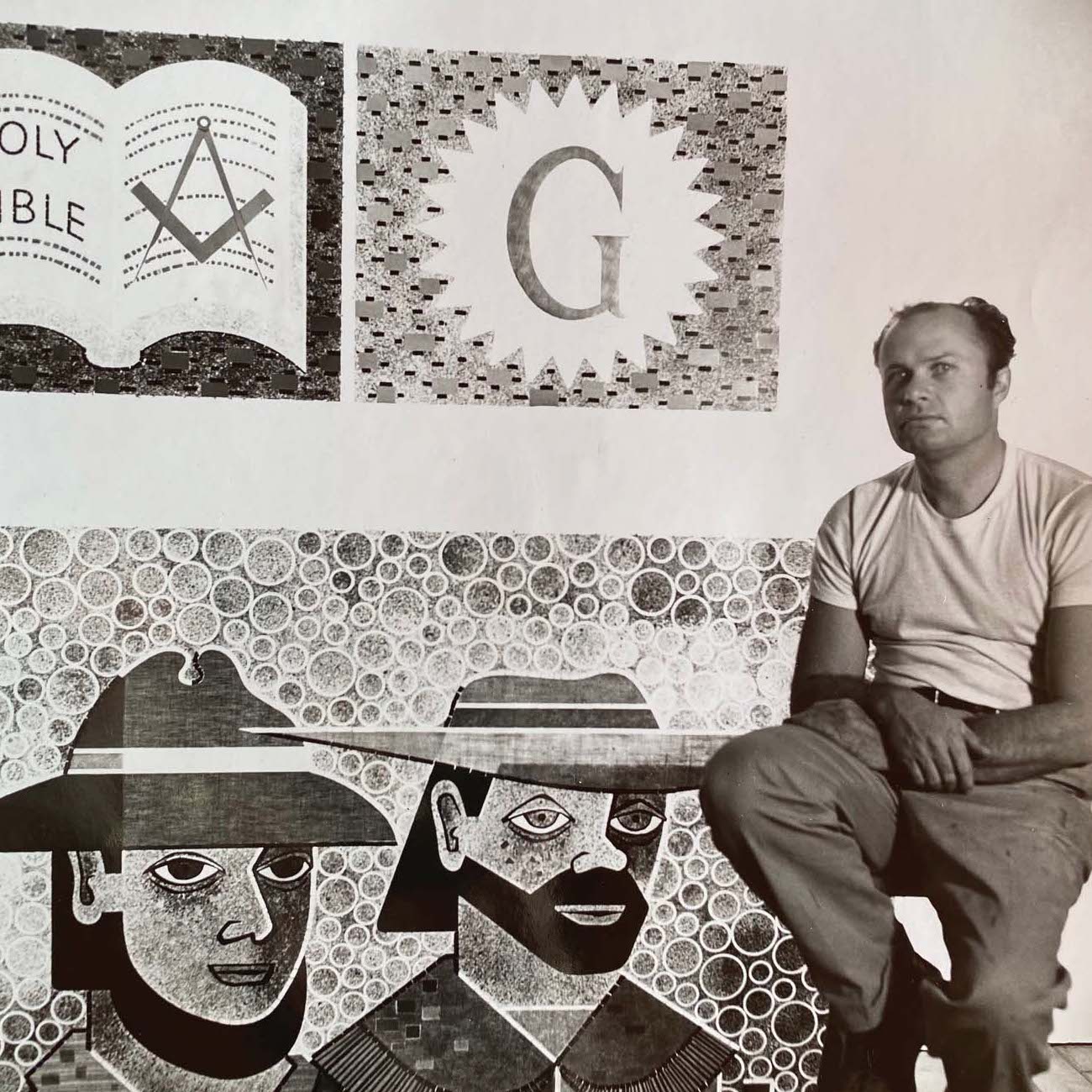
Artist Emile Norman never became a household name. But his massive artwork remains a treasure of California Freemasonry in San Francisco.
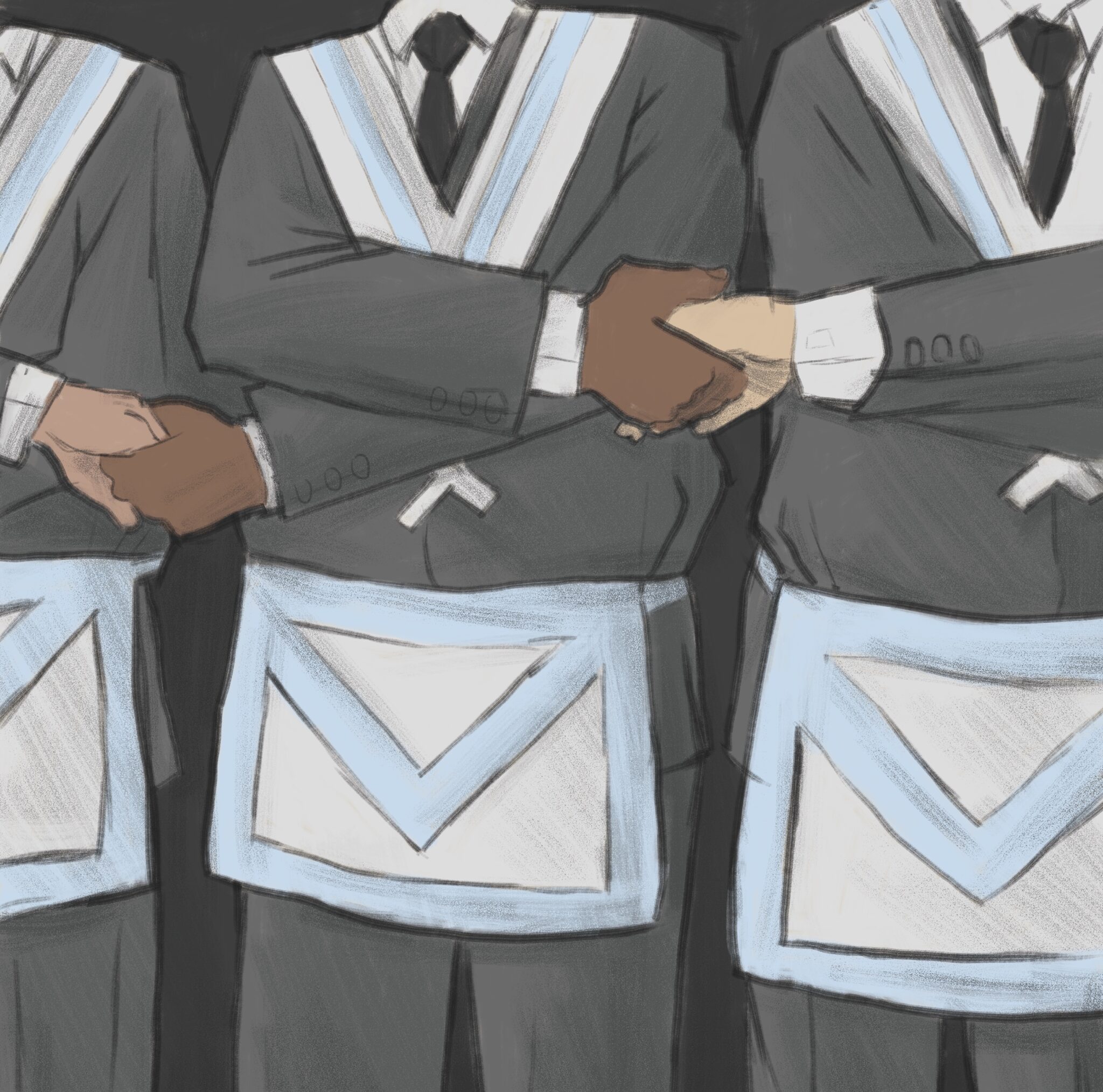
A San Diego Masonic lodge holds a special second degree ceremony with current masters sitting in every lodge position.